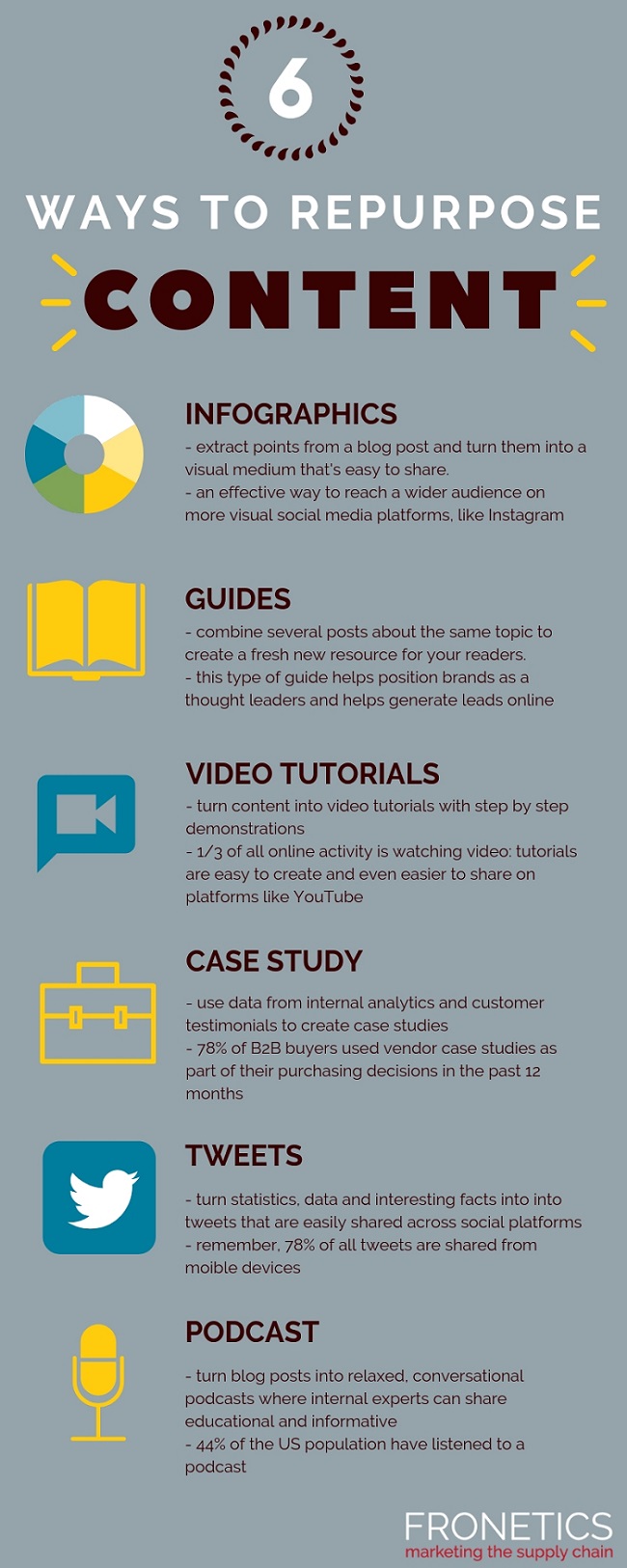
by Fronetics | Dec 5, 2018 | Blog, Content Marketing, Logistics, Marketing, Supply Chain
Content marketing is reshaping the sales process. Here’s what this strategic resource can do for you.
We’ve said it before, and we’ll probably say it again: content marketing is not about making a sales pitch. Nor is it a substitute or replacement for an expert sales staff. However, with the right strategy, and with a closely aligned sales and marketing team, this inbound approach to marketing can revolutionize the way supply chain businesses approach sales.
There’s no question that content marketing has changed the sales process. Thanks to the content and resources available to them, potential customers are more informed as they enter the buyer’s journey. Content marketing helps generate a steady flow of quality leads and provides targeted information to usher prospects down the sales funnel.
[bctt tweet=”Content marketing helps generate a steady flow of quality leads and provides targeted information to usher prospects down the sales funnel.” username=”Fronetics”]
In this new environment, marketing and sales need to work in tandem to be at their most effective. This way they can help each other generate leads, nurture current leads more effectively, and close more deals. Here are three important ways content marketing is changing the way businesses accomplish these goals:
1) Inbound over outbound
Old school marketing was all about outbound — a marketing approach that pushes a message onto a buyer. Traditional advertising — tv and radio ads, telemarketing, banner and display ads — are all examples of outbound marketing. Content marketing takes the opposite approach: inbound marketing.
Inbound marketing focuses on audiences finding you. Instead of pushing a message onto buyers, inbound marketing allows you to establish your brand as an industry leader and let interested audiences come to you. This type of marketing attempts to draw in potential customers through interesting and engaging content.
When it comes to sales, inbound marketing is a game-changer. Content marketing is all about creating a relationship with prospects and paving the way for the sales team to nurture and develop that relationship. Your sales staff is empowered to nurture more leads through to conversion when they are armed with effective, targeted content.
2) Providing information
Once your prospect is ushered into the sales funnel, content marketing can help your sales team continue the conversation. The content you share with prospects at this stage of the buyer’s journey should be designed to answer informed questions and demonstrate that your products and services are there to meet their needs.
Quality content is your sales staff’s best friend. As sales personnel answer questions from prospects and help guide them toward conversion, email, blog, and other types of content are key to keeping prospects interested and moving them down the funnel.
3) Cultivate loyalty
Converting leads is important, but it’s only half the battle. Cultivating loyal customers for your business is crucial to success. Content marketing can not only help you do this, but it can turn those loyal customers into ambassadors for your brand.
Your sales staff should use the high-quality content and guidance provided by your marketing team to engage with satisfied customers on social channels like Facebook, Instagram, and Twitter. Rather than trying to push products, they can use these social spaces to share expert information and foster conversations that will lead other prospects to your business.
Content marketing and sales are a match made in heaven. Curating and creating great content will generate quality leads for your company. It also empowers your sales force to build relationships with potential customers — and close the sale.
Related posts:


by Fronetics | Dec 4, 2018 | Blog, Content Marketing, Logistics, Marketing, Strategy, Supply Chain
Repurposing content is an efficient way to reach a broader audience and build brand awareness.
You spent hours pouring over stats and interesting facts for a blog post. Don’t let all of that effort fall to the wayside. Breathe new life — and reach new audiences — by repurposing that content into engaging new formats.
Some social users like video, while others prefer pictures or podcasts. Taking content and changing its original format is just smart business. Repurposing high-quality content saves marketers time and money and helps to reach a broader audience.
Be picky
Not all of your blog posts and content get the same attention, and that’s ok. Some pieces will resonate more, increasing engagement and driving website traffic.
Run analytics on your content and see what pieces have performed the best. Use tools like Google Analytics to determine your most popular blog posts, your most engaged tweets, or your most viewed videos. This data will help you decide which content should be repurposed. The idea is to take one piece of content and gain visibility and expand your audience by turning it into multiple pieces of content.
The Rule of 7
Repurposing content isn’t just about cutting and pasting content. Have you heard of the Rule of 7? The Rule of 7 is a marketing principle that states your prospects need to encounter your content seven times before they take notice. That’s right, seven times.
[bctt tweet=”The Rule of 7 is a marketing principle that states your prospects need to encounter your content seven times before they take notice. That’s right, seven times.” username=”Fronetics”]
Repurposing content is a great way to take high-quality content and continue to get it in front of audiences without seeming redundant. HubSpot reports that brands who blog around 16 times or more per month get 3.5 times more traffic and 4.5 times more leads than businesses that blog fewer than four times a month. Frequency clearly gets results, but it can also be incredibly time-consuming to create new content 16 times every month. Repurposed content can help your marketing team increase frequency while focusing on quality.
Infographic: 6 ways to repurpose content

(Made with Canva)
Takeaway
How much value does your company put on content? It may be even more important than you think. Use these tips to repurpose high-quality content or yet better, start creating content with these tips in mind. Thinking about a topic and how you can turn that topic into multiple pieces of content will help your hard work go further and perform better.
Related posts:


by Fronetics | Nov 20, 2018 | Blog, Content Marketing, Data/Analytics, Logistics, Marketing, Strategy, Supply Chain
Finding, analyzing, and using the right metrics effectively is crucial to a successful content marketing strategy.
Accountability and showing a solid return on investment is everything when it comes to ensuring that your business is allocating adequate resources to marketing. And let’s face it, too many executives think that marketing is, at best, about supporting sales or, at worst, a department that exists to paste logos onto coffee mugs.
Writing for Marketo, Content Marketing Specialist Bryson Runser points out that as an “informed marketer, it’s your duty to infuse credibility into your organization by way of meaningful metrics that tie directly to your top and bottom line.” While the C-suite famously cares nothing about internal marketing metrics like Facebook likes or click-through rate, metrics are crucial to the success of marketing the supply chain. Not only that, effective use of metrics is the best way to establish the function and importance of the marketing department within your organization.
[bctt tweet=”Effective use of metrics is the best way to establish the function and importance of the marketing department within your organization.” username=”Fronetics”]
Numbers don’t lie
One of the main aspects of the “crisis of accountability” is a problematic view of what marketing is: “if marketing leaders insist that marketing is an art and not a science,” Runser writes,” then the department will remain isolated from other groups.” Establishing that content marketing is not only dependent upon data, but can also be measured, is key to changing that perception.
“Marketing must be able to justify their expenditures as investments in revenue and growth,” writes Runser. Of course, it’s partly a chicken-and-egg issue, since getting to the point of being able to talk about expenditures in this way does require investment from the top of your business.
We know that measuring the impact of content marketing can be tricky. But it’s not impossible. The first step is determining the right metrics to track. For more detailed ideas and analysis, check out this post, which details how to determine and use metrics to measure the impact of content marketing on brand awareness.
Why are you reporting?
Collecting and reporting on marketing ROI can feel like you’re spinning your wheels and collecting meaningless data. But it’s crucial to keep metrics focused on the main goal: to enable you and your business to make decisions that improve your marketing efforts. “This is the difference between backward-looking measurement and decision-focused management,” says Runser.
Data for the sake of data doesn’t do any good. Data should be used to shape insights, which in turn informs priorities and actions for your business. We’ve written before about the danger of vanity metrics, which have no bearing on your bottom line but can give you an inflated sense of success.
It’s very easy to fall into the trap of meaningless data collection, especially when marketers are often struggling to prove their worthiness to the C-suite. But using metrics to improve marketing’s performance will go a long way towards winning over executives. “[B]y aligning data measurements with your company’s strategic objectives,” Runser writes, “it will be easier to allocate resources by revenue impact.”
Related posts:


by Fronetics | Nov 15, 2018 | Blog, Content Marketing, Logistics, Marketing, Social Media, Supply Chain
The popularity of video marketing is on the rise, and savvy supply chain marketers are using this medium to tell their brand’s story, broaden their audience, and generate leads.
Video is the most popular form of content being consumed online today — and it shows no sign of slowing down. Smart supply chain marketers are developing a visual storytelling strategy that offers consistent delivery of valuable content.
Wyzowl’s The State of Video Marketing in 2018 provides a lot of data and an excellent overview of video marketing. Read on for our key takeaways.
Video usage is continuing to grow
Not only are more and more businesses using video as a marketing tool, and planning to continue to do so, but a majority of businesses that don’t use video plan to start doing so this year. This means that supply chain marketing will continue to expand in this more visual direction. Marketers should adjust their strategies to favor content that lends itself to this kind of storytelling.
Of course, it doesn’t take a survey to know that video is taking over the way we consume content. If you use the internet, you’re bound to have seen the significant uptick in video content over the past three years. This medium is now a central part of how we live, and it’s not going anywhere.
When it comes to user experience, video adds a tremendous amount of value. In fact, when both video and text are available on the same page, Wyzowl found that 72 percent of people reported that they would rather use video to learn about a product or service.
[bctt tweet=”When both video and text are available on the same page, Wyzowl found that 72% of people reported that they would rather use video to learn about a product or service.” username=”Fronetics”]
What does this mean for your marketing strategy? The obvious answer is use more video content. Consider accompanying data-heavy blog posts with explanatory animated videos, conducting and sharing video interviews with executives or industry leaders, or turning a case-study into an animated video presentation.
Sharing is everything
Creating compelling video is only half the battle — the next step is making sure it gets to the widest possible segment of your audience. You might think that it’s just cat videos that get shared on social media, but according to Wyzowl, “if you create video content that your specific audience enjoys, 83 percent of consumers would consider sharing it with their friends.”
So, what makes content share-worthy? There aren’t really any gimmicks here. What you need is quality, well-researched content that visually engages viewers. At Fronetics, we’ve written extensively about video marketing. Here are a few posts that may interest you if you’re curious about how video can fit into your content strategy.


by Fronetics | Nov 1, 2018 | Blog, Content Marketing, Logistics, Manufacturing & Distribution, Marketing, Supply Chain
Case studies are a perfect way to organize and present hard facts about your products and services — and they continue to be one of the most effective types of content out there.
A recent study shows that case studies far outperform other types of content. The DemandGen 2017 Content Preferences Survey Report found that 78% of B2B buyers used vendor case studies as part of their purchasing decisions in the past 12 months. 89% of B2B marketers consider customer testimonials and case studies to be the most effective kind of content to convert buyers.
Buyers are looking to “benchmark their own experiences against others who’ve tackled similar challenges,” concluded DemandGen’s report. Data is powerful stuff, and buyers know it. In fact, DemandGen’s survey indicated 48% of buyers not only prefer case studies but find them to be the most valuable type of content for research. 57% even said that they would register and share information in exchange for case studies.
Why the case study?
Beyond the obvious answer that data is important to buyers, why do they respond so well to this type of content? According to Frank Cespedes, Senior Lecturer at Harvard Business School and author of Aligning Strategy and Sales, ultimately, buyers are less interested in theory than practice: “Buyers, especially B2B buyers, want to know what others are doing with your product, not what they might do to improve productivity or other outcomes.”
[bctt tweet=”Yes, case studies are highly effective, but their success is predicated on your reputation as a thought leader and source of knowledge and expertise.” username=”Fronetics”]
As a side-note, before you jump ship on aspects of your content marketing strategy, like blogs, social media, webinars, etc., that focus on sharing ideas rather than just data, consider this: even the most impactful case study is only as useful as the totality of your brand’s content. In other words, yes, case studies are highly effective, but their success is predicated on your reputation as a thought leader and source of knowledge and expertise.
What makes a case study effective?
Not all case studies are created equal. Data presented in a confusing or incomplete way, for example, doesn’t pack the kind of punch needed to demonstrate exactly how your products and services help your buyers. A good case study should prompt the reader to explore your brand and the rest of your content. Ultimately, the goal is to show your prospect that making a change in their process will lead to better results.
As you design a case study, think about giving buyers the tools to present your products and services to decision-makers within their business. “Especially in B2B contexts,” says Cespedes, “buyers must justify a decision to others in the organization who have competing priorities for limited funds.” This is where a compelling case study comes in. Show your potential buyers how other organizations benefit from your offerings, and they have the tools to make a case for your business.
Case studies are proven to be well worth the time and energy needed to produce them. Recommendations and data from real customers have a powerful impact and should continue to be a significant component of your overall content marketing strategy.
Related posts:











